Record Reviews
5 Reviews Found. Use search to find more reviews or follow the links in the review text.
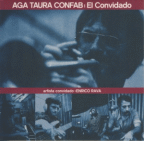 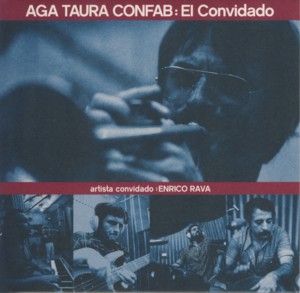 | AGA TAURA CONFAB / ENRICO RAVA ~ EL CONVIDADO
SVART / MONDO 381 (Barcode: 6430065589419) ~ ARGENTINA ~ Jazz-World Fusion
Recorded: 1975 Released: 2019
In June of 1975 Italian trumpeter / composer Enrico RavaFind albums by this artist recorded his debut album for the prestigious German ECMFind albums on this label label, entitled "The Pilgrim And The StarsFind albums with this title", which upon its release later that year kick-started his solo career. The album was recorded with an international lineup of ECM stable musicians: American guitarists John AbercrombieFind albums by this artist (who also released his ECM debut the same year) and a marvelous Scandinavian rhythm section consisting of Swedish bassist Palle DanielssonFind albums by this artist and Norwegian drummer Jon ChristensenFind albums by this artist.
A trumpet virtuoso and an exceptionally gifted composer, Rava established himself on the international scene during the entire decade earlier, playing and recording with the elite of Avant-Garde Jazz players of that period both in Europe and in America, which included Steve LacyFind albums by this artist, Roswell RuddFind albums by this artist, Charlie HadenFind albums by this artist, Don CherryFind albums by this artist, Argentinean Gato BarbieriFind albums by this artist (during his stint in Italy), Lee KonitzFind albums by this artist and others. By the early 1970s Rava embraced a more melodic approach to Jazz and started to cooperate with Fusion musicians, a path common to many of his European contemporaries. This led to his participation in the recording of the seminal Jazz-Rock opera "Escalator Over The HillFind albums with this title" by Carla BleyFind albums by this artist as well as the recording of the little known album for the legendary German MPSFind albums on this label label called "Katcharpari RavaFind albums with this title", where he played vis-à-vis Abercrombie and which, when first heard by ECM owner Manfred EicherFind albums by this artist, led to inviting them both to record for ECM in the first place.
What led Enrico Rava to take part in the recording of the obscure album you are holding in your hand, which took place in December of 1975 in Buenos Aires, the Capital of Argentina, you ask? Well it turns out Rava had some family in Buenos Aires, which he was visiting at the time and which is hardly surprising considering the fact that most of Argentina´s inhabitants are descendants of European ethnic groups, with more than 55% of them having Italian origins. Therefore being Italian and having family in Argentina is a highly probable outcome. Quite accidently, Rava already visited Buenos Aires almost a decade earlier, when playing there with the Steve Lacy quartet. A performance by that quartet recorded in Buenos Aires in November of 1966 was released as the album "The Forest And The ZooFind albums with this title" on the ESPFind albums on this label label.
The rest of the story, however, is pure Jazz "improvisation". Upon learning that Rava is in town, local Jazz aficionados swiftly decided to size the day and hook him up with local musician and record an album. It is difficult to know today if Rava and the Argentineans realized that he was already under ECM contract and they needed to ask Eicher to give them permission to make this recording, which was highly unlikely he would. But considering South American attitude towards rules and regulations nobody probably cared too much about it, which of course in retrospect should make us thankful.
The team selected to accompany Rava, named as "Aga Taura ConfabFind albums by this artist", included three Argentinean Jazz musicians: pianist Fernando GelbardFind albums by this artist, bassist Adalberto CevascoFind albums by this artist and drummer Nestor AstaritaFind albums by this artist and an Argentinean Folk percussionist Farias GómezFind albums by this artist, who also contributed vocalese parts. Although less experienced and with no international exposure at the time, they stood their ground formidably and performed alongside Rava without any inferiority complex. Of the five tunes on the album, four are performed by the quintet, where Gelbard plays the Fender Rhodes electric piano, and one is a duet consisting of Rava and Gelbard, who plays acoustic piano. Not surprisingly Rava´s performances are the absolute pinnacle of the session, encompassing different styles and approaches moving between melodic lyricism and Free Form explorations. He knowingly pays tribute to his idols: Miles Davis and Chet Baker, but avoids copying any explicit phrasing and crafts his distinctly own voice.
The spontaneous recording session lasted for a few hours, just long enough to capture five tracks totaling in about forty two minutes of music. The sound quality of the recording turned out to be better than one might expect, with clear, crispy tone and excellent separation, which suited the music perfectly. The music includes a Rava original, which appears only on this album, a standard, a composition by the Brazilian composer João DonatoFind albums by this artist, a composition by Argentinean saxophonist / composer Horacio BorraroFind albums by this artist and finally a composition by the quintet´s percussionist Farias Gómez – a mixed bag which offers a strong World Music influence and plenty of opportunities for the musicians to show their chops.
In retrospect this is definitely a piece of music that deserves to be revisited, not only for nostalgic reasons, but primarily as a historical document of the period, as well as proof of the fact that music knows no boundaries. Due to its rarity the original LP release is a highly sought after collectors item to Jazz aficionados all over the world, not only connoisseurs of Enrico Rava, but also enthusiasts of early Jazz-World Fusion.
Side Note
The above are my liner notes included on this album's artwork.
I am honored when asked by the Artists to write liner notes for their albums, always hoping that my words reflect the true spirit of the music. This is also a symbol of our mutual respect and friendship developed over the years.
The same is also true when Record Labels ask me to write liner notes for their releases, mostly in the case of reissues of archival albums, which is a symbol of their appreciation of my knowledge and historical perspective and my recognition of their dedication to the preservation of the history of recorded music and the effort to keep human Culture and Aesthetics alive.
| | Updated: 22/05/2020Posted: 22/05/2020 | CD 1 Mini-Sleeve Remastered Recommend To A Friend |
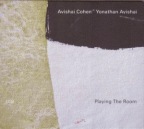  | AVISHAI COHEN / YONATHAN AVISHAI ~ PLAYING THE ROOM
ECM 2641 (Barcode: 602577522772) ~ ISRAEL ~ Jazz
Recorded: 2018 Released: 2019
This is an album by the duo of Israeli Jazz musicians: trumpeter Avishai CohenFind albums by this artist and pianist Yonathan AvishaiFind albums by this artist. The album presents nine tracks, two original compositions (one each by the duo members), one by Israeli composer Alexander ArgovFind albums by this artist, five Jazz standards and one Pop standard. The music was recorded by Stefano AmerioFind albums by this artist and offers the expected sublime sound quality. It is the 3rd album by Cohen released on the ECMFind albums on this label label.
The music is set in a highly melodic, almost romantic mood, relaxed and minimalist, emphasizing the beauty of the compositions and the intimacy of the duo setting, all in the “Art of the Duo” tradition. Both musicians toy with the melodies and rhythmic patterns playfully and charmingly, displaying their complete mastery of their respective instruments, eschewing any flashy displays or unnecessary ornamentation.
One might wonder how these interpretations might have been received by the original composers (John ColtraneFind albums by this artist or Ornette ColemanFind albums by this artist for example), but they would probably just smile, despite the liberties the duo applied to the music. There is no doubt that the ECM mood and aesthetics were closely observed.
Overall, this is a very elegant and highly polished Jazz album, which offers a pleasant listening experience for a wide spectrum of Jazz listeners, but displays the tendency of ECM producer Manfred EicherFind albums by this artist to clutch all the music produced by the label into a uniform aesthetic and aural mould, which at some cases stifles the spirit of the music. Personally I prefer the earlier recordings by Cohen, which display more adventurous approach, but his trumpet work is here, as always, beyond reproach.
| | Updated: 15/09/2024Posted: 15/09/2024 | CD 1 Slipcase Recommend To A Friend |
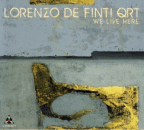 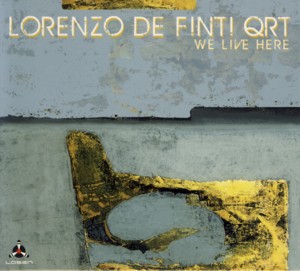 | LORENZO DE FINTI ~ WE LIVE HERE
LOSEN 162 (Barcode: 7090025831621) ~ ITALY ~ Jazz
Recorded: 2015 Released: 2016
This is the fourth album by Swiss / Italian pianist / composer Lorenzo De FintiFind albums by this artist, recorded in a quartet setting with Cuban trumpeter Gendrikson MenaFind albums by this artist (Diaz) and Italian rhythm section: bassist Stefano Dall`OraFind albums by this artist and drummer Marco CastiglioniFind albums by this artist. It presents nine original compositions co-credited to De Finti and Dall`Ora, collectively called "Suite for Jazz Quartet".
The music is modern acoustic Jazz, well within the mainstream idiom, based on lucid melodic themes, typical of European Jazz, beautifully performed by the quartet members, who are all highly professional players. The overall atmosphere is very ECMFind albums on this label like and enthusiasts of the Manfred EicherFind albums by this artist sound should have a field day with this album. The sound and recording quality are simply outstanding. Although there is plenty of European melancholy and fragile balance in this music, I personally fail to hear the alluded connection to Classical music; this is purely a Jazz album from start to finish.
The instrumental work is consistently excellent, especially the trumpet parts, which display a remarkable clarity and sharpness. The music is dominated by the piano, but comes truly alive when the entire quartet is performing. The rhythm section is also exceptional, with the bass being a full partner in the melodic presentation and playing some breathtaking solo parts and the drums, as delicate and compassionate as they are, are unusually inventive and sophisticated at the same time.
Personally the best moments of this album happen when the musicians let go of the composed patterns and improvise spontaneously, albeit briefly, but of course this is a matter of personal preferences. As much as I love the aesthetic beauty of this music, for me it lacks the element of surprise and unexpectedness, which I consider as essential ingredients of the idiom.
But to put things in the right perspective, this is definitely a wonderful album for connoisseurs of mainstream melodic modern Jazz and should make most Jazz fans around the globe very happy. For people with high-end Hi-Fi equipment this is sonic heaven on earth!
| | Updated: 09/08/2016Posted: 09/08/2016 | CD 1 Mini-Sleeve Recommend To A Friend |
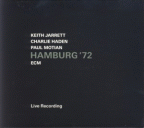 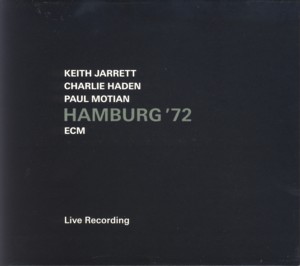 | KEITH JARRETT ~ HAMBURG `72
ECM 2422 (Barcode: 602547042569) ~ USA ~ Jazz
Recorded: 1972 Released: 2014
The piano trio with bassist Charlie HadenFind albums by this artist and drummer Paul MotianFind albums by this artist was Keith JarrettFind albums by this artist´s first ensemble as a leader and he recorded several albums with the trio before adding saxophonist Dewey RedmanFind albums by this artist, creating the so called American quartet. By the time this music was recorded the trio did not perform any more as such and it is probably one of the last if not the last concert they played together, which was recorded. Jarrett plays primarily the piano but also flute, soprano saxophone and percussion. The album includes six compositions, four of which are his ("Everything That Lives Laments" was recorded on the trio´s last album "The Mourning Of A StarFind albums with this title" / "Take Me Back" was recorded on Jarrett´s "ExpectationsFind albums with this title" album just a couple on months earlier), one is by his (then) wife Margot and one by Haden (the famous "Song For Che").
This was a transition period for Jarrett, following his early solo career and the stint with Miles Davis, but before he found his true individual voice, which reached its apex in his trio with bassist Gary PeacockFind albums by this artist and drummer Jack DeJohnetteFind albums by this artist. The seeds of greatness are of course there, but not the fully blossomed genius. Therefore this album suffers from the same problems all the rest of the recordings by that trio suffer from: a lack of focus and consistency. On the other hand it is the best sounding recording (which is hardly surprising) of this trio´s releases.
Overall this is a very important historical document as far as Jarrett´s career is concerned, obviously essential to Jarrett´s enthusiasts following his career closely (and buying absolutely every album he is on), but hardly Jarrett at his absolute best, a curiosity rather than a groundbreaking statement.
God only knows (and perhaps Manfred EicherFind albums by this artist, but it is highly possible they are one and the same) how spacious the ECMFind albums on this label vaults are and how many more archival Jarrett´s albums are going to surface in the future. Hopefully they will prove to be more exciting than this one.
| | | CD 1 Slipcase Remastered Recommend To A Friend |
  | MACIEJ OBARA ~ UNLOVED
ECM 2573 (Barcode: 602557645620) ~ POLAND ~ Jazz
Recorded: 2017 Released: 2017
This is the fourth album by the Polish Jazz saxophonist / composer Maciej ObaraFind albums by this artist and his international quartet, which also features Polish pianist Dominik WaniaFind albums by this artist and Norwegian rhythm section: bassist Ole Morten VaganFind albums by this artist and drummer Gard NilssenFind albums by this artist. It is the first studio recording by the quartet, as the three previous albums, all released on the Polish For TuneFind albums on this label label, were live recordings. It is of course also the first album by the quartet released on the German ECMFind albums on this label label. The album presents seven tracks, six of which are original compositions by Obara and one (the title track) is a relatively infrequently recorded composition by the Godfather of Polish Jazz, Krzysztof KomedaFind albums by this artist. The music was recorded at the legendary Rainbow Studio in Oslo with Jan Erik KongshaugFind albums by this artist in charge of the sonic quality.
Obara´s numerous earlier recordings, including the three albums with the quartet present here, established his position on the Polish Jazz scene as a restless explorer, a rebel and a fearless avant-gardist, who constantly pushed the borders of contemporary Polish / European Jazz. These recordings were uncompromising, adventurous, soaked in free-form and Avant-Garde expressionism, and yet deeply rooted in the Jazz idiom´s tradition.
The fact that this is a studio recording, as already mentioned above, and taking into account the decisive role of Manfred EicherFind albums by this artist, ECM´s supreme boss, who assumed the role of "musical producer" on this album, were obviously bound to have an effect on the outcome, but probably nobody could have imagined how dramatic the transformation was about to become.
The album is clearly divided into two sections (sort of A / B sides of an LP), with the first section (first four tunes) presenting deeply melancholic and introvert music, nicely rounded melodically and harmonically, but alas somewhat pale and monotonous, and the second part (last three tunes) being more ambitious and vibrant, but still not up to par with Obara´s earlier recordings. Gone is the fire and brimstone and the Obara heard on this album is all gentleness and sweetness, delicately uttering lovable notes, who seems to have lost completely the identity he worked for years to establish. Is this the next stage of development for Obara and his quartet? Quite possibly, but his old identity will be sadly missed.
But not everything is lost as far as this album is concerned. Wania manages to escape unspoiled and his work here is as brilliant as always, pure genius in fact. When he solos the music suddenly comes alive and sparks are flying. His brief interludes move elegantly into free-form, albeit briefly, finding the way back within a few bars. In many respects this album is as much Wania´s triumph as it is Obara´s underachievement. Sadly Wania´s brilliant work is not enough to save the album from the lethargic flow of "nice notes". The rhythm section is also excellent proving that playing in a much more relaxed environment is still within their capability and can be done intelligently and excitingly. And of course the sound quality is as heavenly as one might expect.
I am deeply saddened by the fact that this, obviously flagship recording by Obara, turned out to be less than I´d have hoped for. I can only hope that everything will turn for the better in the future.
Side Note: I have to admit that I was completely and utterly flabbergasted by the mass hysteria on the Polish Jazz scene surrounding the fact that this album was released on ECM. It is true that Obara is only the third Polish Jazz leader to have his album released by ECM (preceded by Tomasz StankoFind albums by this artist and Marcin WasilewskiFind albums by this artist), but what does it really mean?
Firstly it means that Manfred Eicher is simply not familiar enough with the burgeoning Polish Jazz scene and its world class talented musicians. If he was familiar with them, he would have surely invited some of them to record for his label, especially in view of the fact that dozens of Polish Jazz albums released by small independent Polish labels are way more interesting and meaningful than most of ECM releases in the last couple of decades.
Secondly it means that ECM is still considered by many people as a leading recording label, whereas in fact it lost its legendary status and influence many years ago. As pioneering and groundbreaking as the label was in the first couple of decades of its existence, bringing up scores of Jazz musicians to the attention of music connoisseurs, the label´s impact and leadership vastly diminished in time. Just ask yourself how many albums in the ECM catalogue do you know / own that were recorded in the 1970s / 1980s and how many albums you know / own that were recorded since 2000? Do the same with a list of recording artists who released albums on ECM in these two periods? The statistics are abundantly clear.
And lastly it means that Polish Jazz scene is completely consumed with the inferiority complex that has always haunted it, looking somewhere else for excellence and example rather than paying tribute to its own Artists and showing them the appreciation they really deserve. Many Polish Jazz fans are still convinced that only Afro-American musicians can play Jazz and everything happening at home is secondary and meaningless, whereas in fact that is completely contrary to the truth.
| | Updated: 12/04/2019Posted: 30/11/2017 | CD 1 Slipcase Recommend To A Friend |
|







